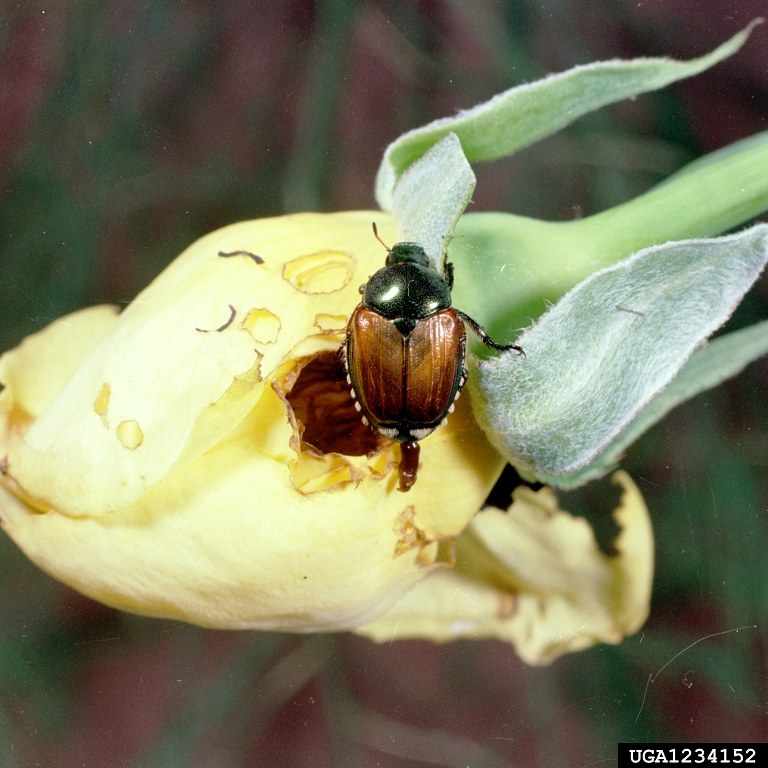Here are some unwelcome invasive guests common around the house or in your garden.

Japanese beetles eating roses Photo:
Brown Marmorated Stink Bug (Halyomorpha halys)
The Brown Marmorated Stink Bug (BMSB) is a native of Asia. It was first collected in the United States in Allentown, PA in 1966. It is considered an agricultural pest in its native range of Korea, Japan, China and Taiwan. It is increasingly an agricultural pest in the United States.
BMSB is a nuisance to homeowners when it attempts to enter homes in September looking for a place to overwinter. It does not reproduce in buildings, but is unpleasant because of their numbers congregating on the outside of houses and their unpleasant odor when disturbed inside. Seal as many cracks in the exterior with calk, especially around windows, doors and vents to prevent their entrance. If they do enter stink bugs can be vacuumed up and removed from the house (dispose of vacuum bag or dump captured insects into water with dish washing detergent to kill them). Using pesticides to kill the insects in the house is not recommended as it will attract carpet beetles that will consume textiles and other organic materials in the house. Pesticides containing synthetic pyrethriods may be used outside to offer some relief.
When the weather becomes colder, the insects will become inactive. Warm days during the winter may cause some to become active. The stink bugs will move out in the spring to begin their life-cycle again. For more detailed information, see the links below.
Brown Marmorated Stinkbug - Penn State Fact Sheet
Multicolored Asian Lady Beetle (Harmonia axyridis)
The variably colored and spotted lady beetle was imported as an effective, natural control for harmful plant pests such as aphids, scale and other soft-bodied arthropods. Its tendency to overwinter in homes and other buildings, sometimes in large numbers, may make them a nuisance. If agitated or squashed, the beetles may exhibit a defensive reaction known as "reflex bleeding," in which a yellow fluid with an unpleasant odor is released from leg joints. This reaction generally prevents predators, such a birds, from eating the beetles. In the home, the fluid may stain walls and fabrics, however, lady beetles are not structure damaging pests and do not lay their eggs in homes.
Lady beetles enter the walls of a building through cracks and crevices. During warm days of late winter and early spring, overwintering beetles in a wall space may become active. Warmer temperatures or lighting in the living areas may attract these active beetles as they search for an exit. Preventing the lady beetles from entering is the best approach to keeping them from becoming a household nuisance. Caulking exterior cracks and crevices - before the lady beetles seek overwintering sites - is the best way to keep them out. This will also keep out other unwanted insects such as wasps and stinkbugs, and will save money on energy costs.
Sweeping and vacuuming are effective methods for removing these lady beetles from living areas. Using insecticides indoors for lady beetle control is not typically recommended.
The Asian lady beetles compete with native lady beetles for habitat. For more information, see the Lost Ladybug Project.
Japanese Beetle (Popillia japonica)
The Japanese beetle is a highly destructive plant pest that can be very difficult and expensive to control. Feeding on grass roots, Japanese beetle grubs damage lawns, golf courses, and pastures. Japanese beetle adults attack the foliage, flowers, or fruits of more than 300 different ornamental and agricultural plants.
Penn State Fact Sheet - Ornamental Plants
Boxelder bugs
These are native to Pennsylvania, but can become a nuisance in certain points in their population cycle. For more information, see this Penn State Fact Sheet.
Additional Resources
Pennsylvania Integrated Pest Management
Pest Problem Solver Page
Gypsy Moth
Gypsy moth is a cyclic insect that has been a problem in York county and will be again.
Invasive Tree Pests
Learn about Emerald Ash Borer, Asian Longhorned Beetle, and Thousand Canker Disease and other tree issues.
Invasive Plants
Many of the plants we see in our yards are not native to the mid-Atlantic region. Some of these plants are not good neighbors, and refuse to stay in our yards, with disastrous consequences.
Aquatic Invasive Species
Invasive species are not restricted to the land. Many invasive species that are problems in our water bodies are also part of our homes, as pets; in ponds or water gardens; or are moved via our recreational activities.
Native Alternatives
Consider the use of native plants in your yards and gardens instead of non-native plants. Here are resources to assist gardeners in making more eco-friendly selections.

